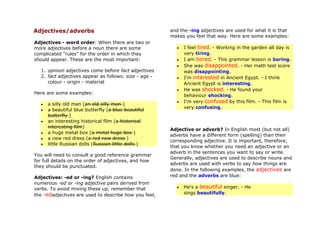Adjective
- 1. Adjectives/adverbs Adjectives - word order: When there are two or more adjectives before a noun there are some complicated "rules" for the order in which they should appear. These are the most important: 1. opinion adjectives come before fact adjectives 2. fact adjectives appear as follows: size - age colour - origin - material Here are some examples: a silly old man (an old silly man ) a beautiful blue butterfly (a blue beautiful butterfly ) an interesting historical film (a historical interesting film) a huge metal box (a metal huge box ) a new red dress (a red new dress ) little Russian dolls (Russian little dolls ) You will need to consult a good reference grammar for full details on the order of adjectives, and how they should be punctuated. Adjectives: -ed or -ing? English contains numerous -ed or -ing adjective pairs derived from verbs. To avoid mixing these up, remember that the -edadjectives are used to describe how you feel, and the -ing adjectives are used for what it is that makes you feel that way. Here are some examples: I feel tired. - Working in the garden all day is very tiring. I am bored. - This grammar lesson is boring. She was disappointed. - Her math test score was disappointing. I'm interested in Ancient Egypt. - I think Ancient Egypt is interesting. He was shocked. - He found your behaviour shocking. I'm very confused by this film. - This film is very confusing. Adjective or adverb? In English most (but not all) adverbs have a different form (spelling) than their corresponding adjective. It is important, therefore, that you know whether you need an adjective or an adverb in the sentences you want to say or write. Generally, adjectives are used to describe nouns and adverbs are used with verbs to say how things are done. In the following examples, the adjectives are red and the adverbs are blue: He's a beautiful singer. - He sings beautifully.
- 2. She's a very quick runner. - She can run very quickly. He's a careless writer. - He writes carelessly. She's a good worker. - She works well. Adverbs are also used to give extra information about adjectives (or other adverbs), as in the following examples: I am extremely happy in my new job. She's in hospital with a seriously injured neck. It's incredibly easy to make a mistake when knitting. The girl climbed dangerously high up the tree. Because of the thick fog I drove extremely carefully. After certain verbs (e.g. be, become, seem, look, taste, smell, etc.) the adjective, not the adverb, is used: She doesn't seem happy today. Don't be stupid! This meat tastes bad. Those flowers smell strange.


